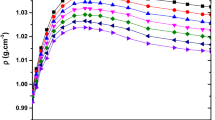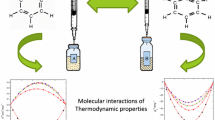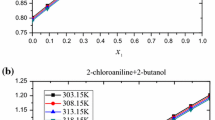Abstract
Volumetric, viscometric and speed of sound studies of binary mixtures of tert-butyl acetate with fluorobenzene, chlorobenzene and bromobenzene have been made over the entire range of composition, at (298.15 and 308.15) K and at atmospheric pressure (p = 0.089 MPa). From the experimental values of density, viscosity, and speed of sound, the excess molar volumes VE, deviations in viscosity ∆η and deviation in isentropic compressibility ΔK S have been calculated. The VE and ΔK S values are negative while the ∆η the values are positive over the entire composition range for the binary mixtures. The derived parameters have been fitted with the Redlich–Kister polynomial equation. The interaction parameters of McAllister model are used to correlate the experimental values of density, viscosity and speed of sound.
Similar content being viewed by others
Avoid common mistakes on your manuscript.
1 Introduction
The thermodynamic and transport properties of binary liquid mixtures help to identify the nature of interactions in the constituent binaries. The compound tert-butyl acetate (t-BAc) is used as a solvent in the manufacture of many industrially many important chemicals such as adhesives and thinners. It is a very effective degreasing agent. Fluorobenzene (FB) is useful solvent for highly reactive species and chlorobenzene (CB) is mainly used as an intermediate in the production of commodities such as herbicides. bromobenzene (BB) is used to introduce a phenyl group via palladium-catalyzed coupling reactions such as the Suzuki reaction. Also it can be used to prepare the Grignard reagent, phenylmagnesium bromide, and as an ingredient in the manufacture of phencyclidine. A literature survey showed that very little work has been done on the mentioned properties for binary mixtures of halogen substituted benzene with branched esters. The interactions between esters and hydrocarbons were reported [1] for the binary mixtures of butyl acetate with some aromatic hydrocarbons. We have previously reported [2, 3] density, viscosity and speed of sound studies of binary mixtures of t-BAc with methanol and hydrocarbons. Herein I present the density, viscosity and speed of sound of t-BAc with FB, CB and BB at 298.15 and 308.15 K.
2 Experimental
2.1 Materials
The FB, CB (Sisco Research Lab Pvt. Ltd., purity > 99.5%), BB, acetone (S.D. Fine Chemicals, purity > 99%) and t-BAc (Spectrochem Pvt. Ltd., purity > 99%), were used after a single distillation. The purity of the solvents, after purification, was ascertained by comparing their densities, viscosities and speed of sound with the corresponding literature values at 298.15 and 308.15 K (Table 1). Binary mixtures were prepared by mass in air-tight stoppered glass bottles. The masses were recorded on an Adairdutt balance to an accuracy of ± 1 × 10−4 kg. Care was taken to avoid evaporation and contamination during mixing. The estimated uncertainty in mole fractions are < 1 × 10−4.
2.2 Apparatus
Densities were determined by using a bicapillary pycnometer as described earlier [4]. The calibration of the pycnometer was done by using conductivity water with 0.99705 kg·m−3 as its density [5] at 298.15 K. The estimated uncertainty of density measurements of solvent and binary mixtures is 0.1 kg·m−3. At least four measurements were made which had an average deviation of ± 0.1 kg·m−3.
The dynamic viscosities were measured using an Ubbelohde suspended level viscometer [4], having a flow time of approximately 300 s at 298.15 K. It was first thoroughly cleaned with warm chromic acid so that there were no obstructions in the capillary and the liquid ran cleanly without leaving drops behind. It was then thoroughly washed by drawing distilled water through it followed by distilled acetone and finally dried by aspirating clean hot air through it. The temperature of the thermostat was controlled within 0.02 K. A mechanical stirrer was used to maintain a uniform temperature. A suitable quantity of the liquid under investigation, usually measured exactly, was introduced into the viscometer with a pipette and allowed 10–15 min to reach the temperature of the thermostat. The liquid was then sucked up and released and the time of out flow between the two marks was determined with an electronic stopwatch reading to 0.01 s. The flow time measurement was repeated a number of times (usually 5 or 6). The different readings did not deviate from the mean by more than 0.2 s. To determine the influence of temperature on viscosity, the time of out flow was measured at 298.15 and 308.15 K. The viscometer was calibrated separately at each temperature with exactly the same volume of a liquid of known viscosity and density, usually water, the density and viscosity of which were taken from the literature [5]. From the densities and times of flow, absolute viscosities of the liquid mixtures were calculated with the help of the equation
where η is the viscosity, ρ is density of the liquid, t is flow time, and a and b are the constants for a given viscometer.
To evaluate the viscometer’s constants, the length of the capillary of the viscometer (ι) term is to be corrected as ι′ = ι + 0.05 r, where r being the radius of the viscometer capillary. Since ι is much larger (150–160 mm) as compared to r (0.5 mm), i.e., ι = ι′ and hence the end effect on the viscometer was negligible. Accuracy of the viscosity measurements was ± 0.001 mPa·s.
The speeds of sound (u) in the solutions were measured at a frequency of 2 MHz through the interferometric method (using Mittal’s F-81 model) at (298.15 and 308.15) K (± 0.02 K). The performance of the interferometer was checked by measurements of the speed of sound of pure liquids such as water, benzene, methylbenzene, isopropylbenzene, and FB and comparing the results with the precise literature values. The uncertainty in speed of sound measurements is ± 0.1%.
2.3 Results and Discussion
The experimental values of ρ, η and u of mixtures at (298.15 and 308.15) K as a function of mole fraction are listed in supplemental material. The density values have been used to calculate excess molar volumes VE using the equation
where ρ denotes the density of solution and x i , ρ i and M i are the mole fraction, density and molar mass of component i, respectively. The viscosity deviations ∆η were calculated using the equation
where η12 is the viscosity of the mixture and x1, x2 and η1, η2 are the mole fraction and the viscosity of pure components 1 and 2, respectively.
The isentropic compressibility κ S was calculated using the Laplace relation,
and the deviation from isentropic compressibility, ∆κ S , was obtained by the relation,
where κS12 is the experimental isentropic compressibility of the mixture, ϕ1, ϕ2 and κS1, κS2 are the volume fraction and isentropic compressibility of the pure components. The volume fraction ϕ i , i = 1, 2, was calculated using the equation
where \( v_{i}^{0} \) are the molar volumes of pure components, 1 and 2.
The excess molar volumes and deviations in viscosity and isentropic compressibility were fitted with the Redlich–Kister [6] equation of the type
where Y is either VE, or ∆η, or Δκ S , and n is the degree of polynomial, the f1 and f2 are mole fractions for VE and ∆η and volume fraction for Δκ S . Coefficients a i were obtained by fitting Eq. 6 to the experimental results using a least-squares regression method. In each case, the optimum number of coefficients was ascertained from an examination of the variation in standard deviation σ.
σ was calculated using the relation
where ‘N’ is the number of data points and ‘n’ is the number of coefficients. The calculated values of the coefficients a i along with the standard deviations σ are given in Table 2.
The variation of VE with the mole fraction x1 of t-BAc for FB, CB and BB at 298.15 K is represented in Fig. 1. The values of VE are negative for all the three binary mixtures studied. The negative values of VE fall in the order BB > CB > FB. The negative values of VE indicate that there is a contraction in volume during the mixing process. This signifies the presence of weak specific interactions and geometrical fitting of one component into the empty space or voids of the other component. The excess molar volumes show dependences on the temperature.
Figure 2 depicts the variation of Δη with the mole fraction x1 of t-BAc. The Δη values are very small and positive for all the three binary mixtures. The Δη values of many organic liquids with aromatic hydrocarbons are characterised by very low (almost ideal nature) values [7,8,9,10,11,12]. The positive Δη values show that there are only weak specific interactions present in the binary mixtures studied. The Δη values show little or no effect of temperature.
The kinematic viscosities (v = η/ρ) of the binary mixtures of t-BAc with FB, CB and BB have been correlated with the help of McAllister’s multi body interaction models [13]. The three-body McAllister’s model is defined by
where ν12 and ν21 are interaction parameters and M1 and M2 are the molecular weights of components 1 and 2.
The correlating ability of Eq. 9 was tested by calculating the percentage standard deviation (σ %) between the experimental and calculated viscosity as
where ‘n’ represents the number of experimental points and m represents the number of coefficients. Table 3 lists the parameters for McAllister equation and percentage standard deviations.
The variation of ∆κ S with mole fraction of t-BAc, x1, is shown in Fig. 3. The values of ∆κ S for mixtures of t-BAc with mole fraction, x1, are also shown in Fig. 3. The values of ∆κ S for mixtures of t-BAc with FB, CB and BB are negative which indicates that the mixtures are less compressible than the individual components, an observation which is very well supported by the sign of VE.
The negative values are in the order FB > CB > BB. Both components of all the binary mixtures (t-BAc and halobenzenes) are polar in nature, therefore dipole–dipole interactions are present in the pure components. When a polar component t-BAc is added to another polar components (i.e., halobenzenes), then there is a possibility that the dipole–dipole interactions between the pure components (like molecules) may be disrupted and new dipole–dipole interactions may take place between unlike molecules. If this interaction is strong then the ∆κ S values should be negative. The negative Δκ S values indicate that these dipole–dipole interactions between unlike molecules are stronger than those between the like molecules.
3 Conclusions
In this work I studied the volumetric properties of binary mixtures of t-BAc with FB, CB and BB. Densities were measured over the temperature range at (298.15 and 308.15) K and at pressure 0.087 MPa.
The values of VE are negative for all the three binary mixtures, which indicates that there is a contraction in volume during the mixing process. The Δη values are very small and positive for all the three binary mixtures. These values show little or no effect of temperature, which means there are only weak specific interactions present in the binary mixtures. The values of ∆κ S are negative, which indicates that the mixtures are less compressible, an observation which is very well supported by the sign of the excess molar volumes. For binary mixtures parameters of the Redlich–Kister equation and McAllister’s model were fitted to the experimental VE, Δη and ∆κ S values.
References
Chandrasekhar, G., Venkatesu, P., Prabhakara Rao, M.V.: Excess volumes and ultrasonic studies of N, N-dimethyl acetamide with substituted benzenes at 303.15 K. Phys. Chem. Liq. 40, 181–189 (2002)
Hasan, M., Hiray, A.P., Kadam, U.B., Shirude, D.F., Kurhe, K.J., Sawant, A.B.: Densities, sound speed and IR studies of (methanol + 1-acetoxybutane) and (methanol + 1,1-dimethylesters) at (298.15, 303.15, 308.15, and 313.15) K. J. Chem. Eng. Data 55, 535–538 (2010)
Hasan, M., Sawant, A.B., Sawant, R.B., Loke, P.G.: Densities, viscosities, speed of sound and IR spectroscopic studies of binary mixtures of tert-butyl acetate with benzene, methylbenzene and ethylbenzene at T = (298.15 and 308.15) K. J. Chem. Thermodyn. 43, 1389–1394 (2011)
Kadam, U.B., Hiray, A.P., Sawant, A.B., Hasan, M.: Densities, viscosities, and ultrasonic velocity studies of binary mixtures of trichloromethane with methanol, ethanol, propan-1-ol, and butan-1-ol at T = (298.15 and 308.15) K. J. Chem. Thermodyn. 38, 1675–1683 (2006)
Marsh, K.N.: Recommended Reference Materials for the Realization of Physicochemical Properties. Blackwell Scientific Publication, Oxford (1987)
Redlich, O., Kister, A.T.: Algebraic representation of thermodynamic properties and the classification of solutions. Ind. Eng. Chem. 40, 345–348 (1948)
Nikam, P.S., Kharat, S.J.: Densities, viscosities, and thermodynamic properties of (N, N-dimethylformamide + benzene + chlorobenzene) ternary mixtures at (298.15, 303.15, 308.15, and 313.15) K. J. Chem. Eng. Data 48, 1202–1207 (2003)
Viswanathan, S., Rao, M.A., Prasad, D.H.L.: Densities and viscosities of binary liquid mixtures of anisole or methyl tert-butyl ether with benzene, chlorobenzene, benzonitrile, and nitrobenzene. J. Chem. Eng. Data 45, 764–770 (2000)
Singh, S., Sethi, B.P.S., Katiyal, R.C., Rattan, V.K.: Viscosities, densities, and speeds of sound of binary mixtures of o-xylene, m-xylene, p-xylene, and isopropylbenzene with 2-butanone at 298.15 K. J. Chem. Eng. Data 50, 125–127 (2005)
Varshney, S., Singh, M.: Densities, viscosities, and excess molar volumes of ternary liquid mixtures of bromobenzene + 1,4-dioxane + (benzene or + toluene or + carbon tetrachloride) and some associated binary liquid mixtures. J. Chem. Eng. Data 51, 1136–1140 (2006)
Yang, C., Xu, W., Ma, P.: Excess molar volumes and viscosities of binary mixtures of dimethyl carbonate with chlorobenzene, hexane, and heptane from (293.15 to 353.15) K and at atmospheric pressure. J. Chem. Eng. Data 49, 1802–1808 (2004)
Sawant, R.B.: Volumetric, viscometric, acoustic and IR spectroscopic studies of binary mixtures of tert-butyl acetate with isopropylbenzene, isobutylbenzene and methoxybenzene at T = 298.15 and 308.15 K. J. Phys. Chem. Biophys. 6, 225 (2016). https://doi.org/10.4172/2161-398.1000225
McAllister, R.A.: The viscosity of liquid mixtures. AIChE J. 6, 427–431 (1960)
Sakurai, M., Nakamura, K., Nitta, K.: Partial molar volumes of alkyl acetates in water. J. Chem. Eng. Data 41, 1171–1175 (1996)
Sakurai, M., Nakamura, K., Nitta, K., Takenaka, N., Mukae, K.: Partial molar isentropic compressions alkyl acetates in water. J. Chem. Eng. Data 43, 249–254 (1998)
Villares, A., Rodriguez, S., Lafuente, C., Royo, F.M., Clopez, M.C.: Viscometric study of some cyclic ethers with benzene. J. Solution Chem. 33, 1119–1133 (2004)
Aminabhavi, T.M., Aminabhavi, V.A., Balundgi, R.H.: Excess properties of binary mixtures of fluorobenzene with aliphatic liquids in the temperature range 298.15–313.15 K. Indian J. Technol. 29, 473–477 (1991)
Gascon, I., Giner, B., Rodriguez, S., Lafuente, C., Royo, F.M.: Thermophysical properties of the binary mixtures of 2-methyl-tetrahydrofuran with benzene and halobenzenes. Thermochim. Acta 439, 1–7 (2005)
Nigam, R.K., Maini, N.N., Dhillon, M.S.: Excess volumes of mixing and viscosities of binary liquid mixtures of chlorobenzene and bromobenzene with o-, m-, and p-xylenes. Indian J. Chem. 11, 1288–1292 (1973)
Nikam, P.S., Kapade, V.M., Hasan, M.: Molecular interactions in binary mixtures of chlorobenzene with normal alkanols (C1–C4)—an ultrasonic study. J. Pure Appl. Ultrason. 22, 16–20 (2000)
Abdulghanni, H.N., Abdul-Fattah, A.A.: Densities and kinematic viscosities of ten ternary regular liquid systems at 293.15 and 298.15 K. J. Chem. Eng. Data 45, 991–995 (2000)
Rath, D.C., Kar, P.K.: Intermolecular free length and molecular interaction studies in binary mixtures of ketones with aromatic hydrocarbons. J. Pure Appl. Ultrason. 25, 58–63 (2003)
Joshi, S., Aminabhavi, T.M., Shukla, S.S.: Densities and shear viscosities of anisole with nitrobenzene, chlorobenzene, carbon tetrachloride, 1,2-dichloroethane, and cyclohexane from 25 to 40 °C. J. Chem. Eng. Data 35, 247–253 (1990)
Nigam, R.K., Singh, P.P.: Viscosity and molecular interaction in binary mixtures of benzene and toluene with chloro-, and bromobenzene. Indian J. Chem. 9, 671–691 (1971)
Muhammad, G.S., Balkrishnan, R., Rajsekaran, J.F.: Ultrasonic studies on HTPB in chlorobenzene. J. Pure Appl. Ultrason. 21, 71–74 (1999)
Aminabhavi, T.M., Aminabhavi, V.A., Joshi, S.S., Balundgi, R.H.: Excess properties of some binary liquid mixtures in temperature range 298.15–313.15 K. Indian J. Technol. 29, 545–557 (1991)
Nikam, P.S., Kapade, V.M., Hasan, M.: Molecular interactions in binary mixtures of bromobenzene with normal alkanols (C1–C4): an ultrasonic study. Indian J. Pure Appl. Phys. 38, 170–173 (2000)
Manjeshwar, L.S., Aminabhavi, T.M.: Densities and viscosities of binary liquid mixtures at 45 °C. J. Chem. Eng. Data 32, 409–412 (1987)
Oswal, S.L., Kotiya, A.G., Pandya, M.V.: Density and excess volumes for binary solution of tetrahydrofuran with methyl cyclohexane, chlorobenzene, bromobenzene, toluene, ethylbenzene and acetonitrile. Indian J. Chem. 17, 605–607 (1979)
Miller, L., Carman, P.C.: Self-diffusion in mixtures. Part-2 Simple binary mixtures. Trans. Faraday Soc. 35, 1831–1837 (1959)
Acknowledgements
The author is thankful to the Principal, M.S.G. College, Malegaon Campus for providing laboratory facilities and University Grants Commission, New Delhi for financial assistance.
Author information
Authors and Affiliations
Corresponding author
Electronic supplementary material
Below is the link to the electronic supplementary material.
Rights and permissions
About this article
Cite this article
Sawant, R.B. Volumetric, Viscometric and Speed of Sound Studies of Binary Mixtures of Tert-butyl Acetate with Fluorobenzene, Chlorobenzene and Bromobenzene at (298.15 and 308.15) K and at Atmospheric Pressure 0.087 MPa. J Solution Chem 47, 787–795 (2018). https://doi.org/10.1007/s10953-018-0752-x
Received:
Accepted:
Published:
Issue Date:
DOI: https://doi.org/10.1007/s10953-018-0752-x







